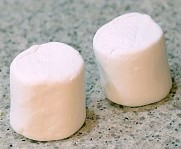science notes
Decibel Levels of Various Foods
by Harvey Snappe, C.K. Crackelson, and Herbert W. Popper
 ne of life's greatest mysteries is the question of which food makes the most
noise. In the interests of science we have investigated this burning question.
ne of life's greatest mysteries is the question of which food makes the most
noise. In the interests of science we have investigated this burning question.

Marshmallow Specimens
| Food Item | Decibel level (dBA) |
|---|---|
| Marshmallow (normal size) | 38 |
| Marshmallow (Jumbo size) | 38 |
| Marshmallow (stale) | 73.6 |
| Celery | 53-55 |
| Potato Chip (Lays, BBQ, Mouth Closed) | 50-56 |
| Potato Chip (Mouth Open) | 63 |
| Potato Chip Bag Opening | 77 |
The marshmallow was the quietest food item tested, at 38 decibels, barely above the background level of 37.2 dBA. However, one marshmallow had a peak sound level of 73.6 decibels. This particular specimen, found in the back of the refrigerator, was found to be extremely crunchy. Unfortunately, marshmallows rapidly absorb water and become softer upon exposure to the atmosphere. Thus, we have so far been unable to replicate this reading.
The second-loudest items tested were potato chips. For this experiment we selected a Lays Barbecue-flavored potato chip, which is a popular brand with a colorful photograph of two unbroken potato chips on the front of the package. This was, however, found not to be representative of their true appearance.
The sound produced by these chips was quite variable in intensity, varying from 50 to 56 decibels, depending on the chip selected and how it was chewed. On average, the potato chips were slightly louder than the celery, which came in at around 53 dBA. One lab claims that celery is actually noisier than potato chips (Snapchik, Crackelson and Popper, 1997). We are highly skeptical of this claim. Further investigation is needed to resolve the question of why their lab invariably obtains higher and more variable decibel readings than ours, yet somehow still manages to receive more funding.
In contrast to marshmallows, which became crunchier over time, stale potato chips were quieter than fresh ones. The decibel level of celery also decreased significantly after 14 days in our refrigerator. We attribute this primarily to a loss of structural rigidity.
Opening the potato chip bag produced the loudest sound by far, about 77 decibels. Eating a potato chip with the mouth open, with the experimenter attempting to direct the sound toward the microphone, only increased the sound by 7 decibels. However, our assistant described this procedure as “disgusting” as it occasionally resulted in small sections of potato chip flying off in random directions.
It has also been reported that apples can be quite noisy. More research is needed.
